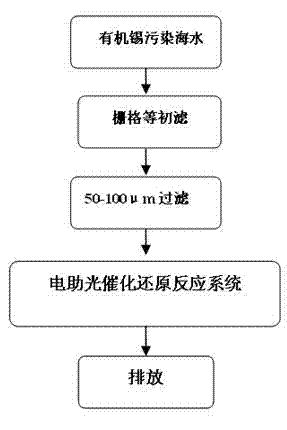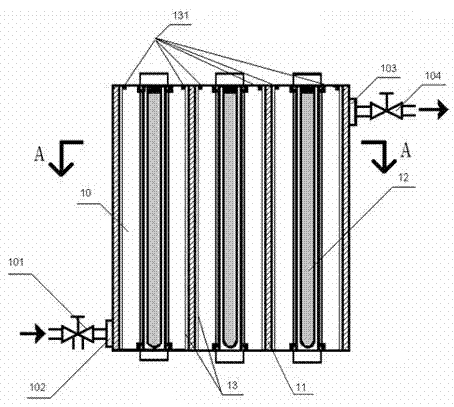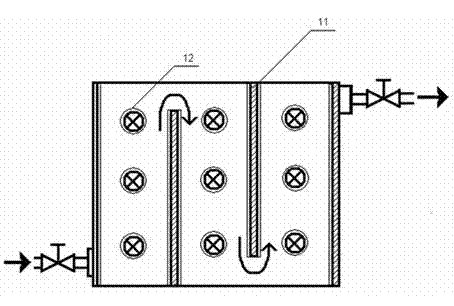Purification treatment method for organotin-polluted seawater
A purification treatment and organic tin technology, applied in the field of water treatment, can solve the problems of marine resource decline, endangering people's health, and no detoxification and repair, and achieve the effects of increased degradation rate, thorough mineralization, and wide application range
- Summary
- Abstract
- Description
- Claims
- Application Information
AI Technical Summary
Problems solved by technology
Method used
Image
Examples
Embodiment 1
[0045] It was taken from the surface seawater of Wusong Port in Shanghai. The pH value of the seawater was 7.45 and the salinity was 23.1psu. At the same time, the content of tributyltin was found to be 16.8μg / L through high performance liquid chromatography analysis. First, it was passed through a filter with a pore size of 100μm After filtering, it is pumped into the electric-assisted ultraviolet photocatalytic reduction reaction system. In the reaction system, the ultraviolet light source adopts a low-pressure mercury lamp capable of emitting a main wavelength of 254nm, and the reduction photocatalyst material is TiO with industrial pure titanium mesh as the supporting substrate. 2 -NiO-CuO composite metal oxide (the composition ratio of each metal oxide is molar ratio: TiO 2 : NiO:CuO=5:55:40), using a lithium-ion battery as the power supply of the applied electric field, the voltage of the applied electric field remains -0.14V~-0.20V; polluted seawater is fully contacted w...
Embodiment 2
[0047] The seawater was taken from the surface layer of Xiangshan Port in Ningbo. The pH value of the seawater was 7.32 and the salinity was 21.6psu. At the same time, the content of tributyltin was found to be 11.5μg / L by high performance liquid chromatography. After the filter is filtered, it is pumped into the electric-assisted ultraviolet photocatalytic reduction reaction system. In the reaction system, the ultraviolet light source adopts a low-pressure mercury lamp capable of emitting a main wavelength of 185nm. The reduction photocatalyst material is an industrial pure titanium mesh as a supporting substrate TiO 2 -NiO-CuO composite metal oxide (the composition ratio of each metal oxide is molar ratio: TiO 2 : NiO:CuO=10:30:60), using a lithium-ion battery as the power source of the applied electric field, the voltage of the applied electric field is maintained at -0.25V~-0.27V; polluted seawater is fully contacted with the reduced photocatalyst material in the reaction ...
Embodiment 3
[0049] The surface seawater was taken from Shanghai Yangshan Port. The pH value of the seawater was 7.55 and the salinity was 24.1psu. At the same time, the content of tributyltin was found to be 12.9μg / L by high-performance liquid chromatography. Firstly, the pore size was 100μm After being filtered by the filter, it is pumped into the electric-assisted ultraviolet photocatalytic reduction reaction system. In the reaction system, the ultraviolet light source adopts a low-pressure mercury lamp capable of emitting 185nm and 254nm wavelengths. The reduction photocatalyst material is industrial pure titanium mesh as the supporting substrate TiO 2 -NiO-CuO composite metal oxide (the composition ratio of each metal oxide is molar ratio: TiO 2 : NiO:CuO=1:55:44, using lithium-ion battery as the power supply of the external electric field, the voltage of the external electric field is maintained at -0.32V~-0.34V; polluted seawater is fully contacted with the reduced photocatalyst mat...
PUM
 Login to View More
Login to View More Abstract
Description
Claims
Application Information
 Login to View More
Login to View More - Generate Ideas
- Intellectual Property
- Life Sciences
- Materials
- Tech Scout
- Unparalleled Data Quality
- Higher Quality Content
- 60% Fewer Hallucinations
Browse by: Latest US Patents, China's latest patents, Technical Efficacy Thesaurus, Application Domain, Technology Topic, Popular Technical Reports.
© 2025 PatSnap. All rights reserved.Legal|Privacy policy|Modern Slavery Act Transparency Statement|Sitemap|About US| Contact US: help@patsnap.com



